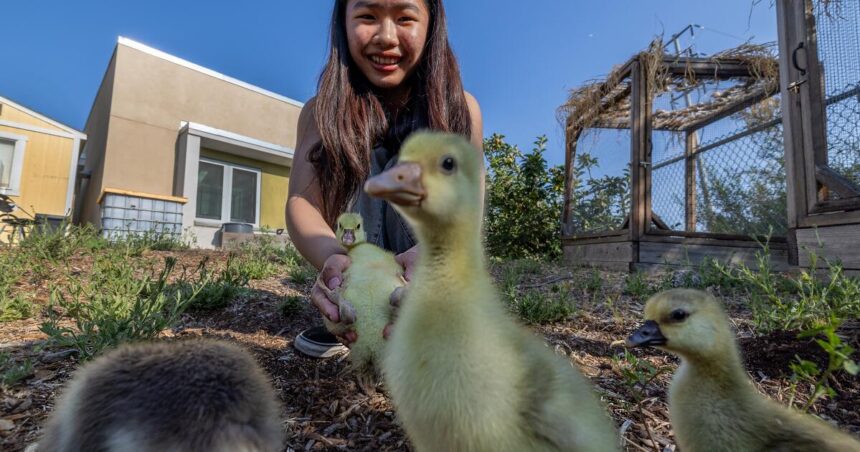You might miss it when driving by, but behind the campus of Sotomayor Arts & Sciences Magnet High School in Glassell Park, between the football field and active subway and freight train tracks, lies a 1.75-acre farm.
A herd of Irish Dexter cattle, a herd of New Zealand Kunekune pigs, Babydoll Southdown sheep and a variety of feathered birds are just some of the zoo’s inhabitants, which live amongst fruit trees, vegetable patches and an abundance of native vegetation along rainwater collection depressions.
“Agriculture can reset natural ecosystems and be part of the solution to climate change,” said Reis Flores, an agricultural educator in Sotomayor’s career and technical education (CTE) program, which operates separate from the rest of the academic curriculum.
Raising endangered species is an opportunity to learn about the importance of biodiversity, he said. The first discussion topic in his urban farm-to-table class each semester is the impact of eating meat on the climate. “Students get to understand animals as other sentient beings,” he said.
When the Los Angeles Unified School District opened the school for grades 6-12 in 2011, agriculture was included in the curriculum plans as a vestige of the area’s agricultural past, but the project stalled until Flores and his teaching partner, Arturo Romo, an artist who works with natural dyes and fibers, came on board.
Flores said CTE prepares 230 students each semester for the workforce, and graduating students are more likely to find employment with environmental organizations than industrial agriculture companies.
Flores has been given autonomy to run the farm as he sees fit, and he teaches students organic and sustainable gardening practices that emphasize harmony with nature. “It’s regenerative agriculture,” he says, and it can help repair the environment and protect against climate change.
Students add cow manure to food leftovers from their classes and the school cafeteria to create compost for soil in their vegetable gardens. They learn how the farm’s pigs eat everything, including leftover milk, and they get to work digging around their straw beds to make compost.
Class time is spent working on the farm, Flores said. He works alongside his students first and discusses any work. “Water as much as you eat,” he tells them. “Waste is a resource.”
Farm animals are not part of the meal plan, but are part of the instruction plan. Farm to Table Cooking Classes are vegetarian.
Flores said the students run the facility, cultivating their own gardens and caring for the animals: “I step back and let them do it once they get the hang of it.”
He says job proficiency is a better measure of learning than any written test.
“These kids are so bright,” Flores said. The Title I school has 516 students, 95 percent of whom are economically disadvantaged. “They do so much work on school grounds,” Flores continued. “The farm allows them to learn and succeed in a different way than other kids, which is good for both the special needs students and the high-achieving students.”
Flores said he has raised funds to cover the costs of the program, dedicating an estimated 100 hours of his personal time over the past three years to applying for local, state and federal grants to keep the farm afloat, including the Perkins Grant, which ranges from $25,000 to $60,000 a year, “a competitive grant that funds materials and equipment for the program,” Flores said.
“It would be extremely helpful if school districts fostered spaces like ours as ‘climate literacy learning’ and gave teachers the tools they needed to teach it,” Flores said.
Some teachers use the farm as a laboratory for special projects: A social studies class that reads Michael Pollan’s “eat mostly plants, not too much” philosophy comes to the farm to see how his principles are put into practice, Flores said.
Flores’ teaching partner, Romo, connects the farm lessons to his Chicano heritage: “I was raised with respect for the earth,” he says. “We’re part of the earth, so we take care of the earth, and the earth takes care of us.”
“The students learn about the connection between the ecosystem on the farm and their own history; how their history is connected to the willows on our farm and the history of the Native Americans here; and how to treat the Earth with respect,” Romo added.









